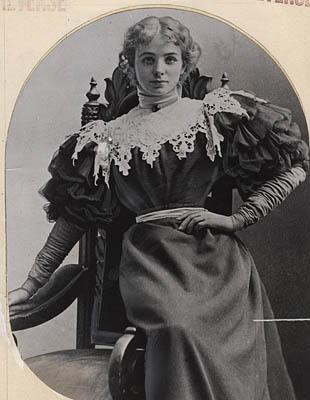This is an archived article that was published on sltrib.com in 2006, and information in the article may be outdated. It is provided only for personal research purposes and may not be reprinted.
Maude Adams was an international sensation. Before there was J-Lo, Madonna, Grace Kelly, Marilyn Monroe, Katharine Hepburn, there was Maude Adams. Before Greta Garbo ever uttered, "I vant to be alone," Maude Adams sought solitude from adoring fans.
Maude was beautiful, soulful, unapproachable. As America's premier actress, her face graced the tabloids and newspapers of the time. J.M Barrie was so taken with her talent that he adapted his book, Peter Pan, to the stage so she could play his ephemeral Peter.
Years earlier, it was rumored that Brigham Young was so smitten with Maude's mother that he wanted her as one of his wives.
Young was a fan of the theater. While in Nauvoo he occasionally played a spear carrier in productions just to be close to the action. Soon after pioneers arrived in the Salt Lake Valley, Young sponsored an acting company.
Maude's mother, Annie Adams, was a longtime member of the troupe. Presumably having fended off Young's importunities, she fell for an itinerant actor, James Kiskadden. They married. Maude was born in 1872. The young family took to the road, and Maude soon was taking bit parts reserved for children and intelligent animals. Foreshadowing what would later be called method acting, the 7-year-old Maude insisted that, in a scene requiring her to drink beer, the real thing be served up.
Precocious and preternaturally smart, Maude nonetheless found serious acting daunting. She won her first part as a leading lady at 15. She claimed she'd flopped, and that her fellow actors turned their faces away as she exited the stage to spare her feelings.
Maude can be forgiven for discounting early accomplishments that undoubtedly were less disastrous than she remembered. In biographies, she revealed a touching sense of insecurity. One states that meeting people fatigued her, partly because of her shyness - even among her friends.
Unlike today's celebrities, Maude shunned publicity. No party girl, she preferred to retire to her room to read volumes on history, sociology and philosophy, even taking notes. The romantic sliver of her life pried open by the tabloids revealed a maddeningly celibate existence. She mocked herself as being a thoroughly incompetent Juliet. But the stage transformed her.
The shrinking violet suddenly burned like a nova. Critics lavished their praise. Crowds packed the theater, once giving her 20 ovations.
Maude's love of privacy only fired public interest. As her popularity grew, she was mortified at being recognized in public and scarcely knew how to comport herself. She rarely granted interviews and traveled incognito. So her luggage wouldn't be recognized and give away her lodgings to snooping reporters, she devised a symbol to take the place of her name.
In a triumphant return to Utah in 1910, Maude was celebrated by the Salt Lake City Council in a resolution that praised her as the state's "most illustrious daughter," and "the highest type of modest womanhood; idol of the American stage."
The next day she performed in "What Every Woman Knows," the proceeds going to the Salt Lake Orphans Home.
Before being socially conscious was seen as a smart career move, Maude gave as a matter of course. A flood that killed 400 in Dayton, Ohio, prompted a generous, anonymous donation. During World War I, she performed for convalescent soldiers. The women in her troupe knitted socks for the U.S. Army.
Early on, Maude had found peace and solitude in retreat homes run by Catholic convents, and in 1917 she donated her estates at Lake Ronkonkoma in New York to the Sisters of St. Regis.
While still a vital figure at the dawn of motion pictures, Maude seemed to sense that her time had passed. Acting parts and screenplays came and fell through - little to her disappointment. She was more interested in the arcana of stage lighting. To develop more effective theater lights, General Electric consulted with her. Invited to start a school of acting in a Missouri college in 1937, she accepted and was involved in the theater department until 1950.
Never married, she died in 1953.



